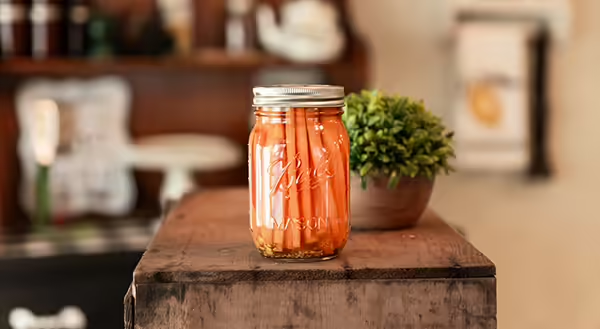
Canning
- There are two methods of canning- boiling water bath canning and pressure canning. The pH of the food you are preserving will determine which type of canner to use. The boiling-water canning method is used for acidic foods, meaning those having a pH value of 4.6 or less. Most fruits are naturally high in acid and are safe to process using this method. However, some fruits must have additional acid added because they lack the level of acid needed to prevent spoilage. These foods include tomato products and figs which have a pH value right around 4.6. Other acidified foods can also be canned safely with this method.
- Low-acid foods (pH greater than 4.6) must be canned in a pressure canner which is not to be confused with a pressure cooker. Examples of low-acid foods include vegetables, meat, poultry and fish. The use of a pressure canner is necessary to prevent botulism.
- Canning methods not recommended include, processing by way of the microwave or dishwasher, solar canning, open kettle canning or oven canning.
- Canning is a science to it’s important to use tested recipes. Unfortunately, old cookbooks and recipes handed down from great grandma probably aren’t following current recommendations. Sources where you can find tested recipes include the National Center for Home Food Preservation website, the 6th edition of So Easy to Preserve or any state Extension website. Also check to make sure the recipe is recent. You’ll want to see a publication date of 1985 or newer.
Freezing
- There are certain things we can do to improve the quality of our frozen foods. Water makes up 70-90% of the weight of most fruits and vegetables. During the freezing process, water expands, and ice crystals are formed causing the cell walls to rupture. If we freeze produce as quickly as possible, smaller ice crystals will form resulting in a better quality product when thawed. For this reason only freeze 2-3 pounds of food per cubic feet of space within 24 hours. Slow freezing will result in a softer texture and more liquid loss when thawed.
- Blanching is a must for almost all vegetables. This will help maintain the color, flavor and texture of the frozen food.
- It’s also a good idea to freeze your food flat for better circulation and to use good quality freezer packaging which will help protect against freezer burn.
Drying
- Dehydrators produce the best quality product as compared to other methods of drying because the air is continuously circulated. The oven can take 2-3 times longer and will likely not reach the low temperatures achieved by using dehydrators. Also, some foods can take up to 40 hours to dry so you don’t want to leave your oven running that long!
- Like freezing you’ll want to blanch your vegetables first. If you omit this step, or inadequately blanch them, they will have poor flavor and color.
- It’s also highly recommended to pretreat most fruits. You can use Vitamin C, citric acid or lemon juice as well as honey and fruit juice. For more information about pretreatment procedures, check out this University of Georgia Extension PDF (page 3).
- Once your foods are fully dried and cooled they should be stored in moisture-vapor resistant containers like glass jars or freezer containers. Most fruits will last for about 1 year and most vegetables 6 months in dry storage. If you need to preserve them longer, freezing is recommended.
Illinois Extension's Nutrition & Wellness Team recorded an 8-week food preservation webinar series covering the different types of food preservation methods plus presentations specific to jams/jellies, pickles, apples and tomatoes. You can access these recordings and handouts by visiting, go.illinois.edu/NutritionWebinars. Follow this link and scroll down to the “Fill Your Pantry” series.
If you live in Illinois and need your pressure canner dial gauge tested, please visit Pressure Canner Testing: University of Illinois Extension to find an office near you.
Additional resources for safe home food preservation:
Watch Your Garden Grow - University of Illinois Extension
Food Preservation Resources - University of Illinois Extension
Source: Kristin Bogdonas is the nutrition & wellness educator for University of Illinois Extension serving Henry, Mercer, Rock Island and Stark Counties.